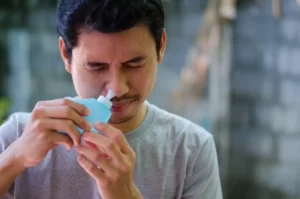The Ultimate Guide To Nasal Douche / Nasal Douching
If you’ve ever experienced sinus problems, you know how uncomfortable and frustrating they can be. Nasal douching, also known as saline nasal irrigation, is a simple and effective way to improve sinus health and breathe easier. By flushing out irritants and excess mucus, nasal douching can provide relief from congestion, allergies, and other sinus-related issues. In this article, we’ll explore the benefits of nasal douching and provide you with the top products and resources for achieving optimal sinus health.

Medically Reviewed By:
Dr Leslie Koh
M.B;B.S. (Singapore), MRCS (ENT) Edinburgh, M. Med (ORL), FAMS
Definition Of Nasal Douching
 Nasal douching is a technique used to cleanse the nasal passages of mucus and other irritants. The process involves flushing the nasal passages with a saline solution. Nasal douching has a number of benefits, including relieving symptoms of nasal congestion, removing harmful irritants from the nasal passages, and promoting overall nasal and sinus health. The following patients may also benefit from nasal douching:
Nasal douching is a technique used to cleanse the nasal passages of mucus and other irritants. The process involves flushing the nasal passages with a saline solution. Nasal douching has a number of benefits, including relieving symptoms of nasal congestion, removing harmful irritants from the nasal passages, and promoting overall nasal and sinus health. The following patients may also benefit from nasal douching:
- Patients with acute or chronic sinusitis;
- Patients who are post-functional endoscopic sinus surgery or turbinate reduction;
- Patients with acute upper respiratory tract infections
Benefits Of Nasal Douching
Therapeutic Benefits
Nasal douching can help to relieve symptoms of nasal congestion and pressure, making it a popular remedy for conditions such as the common cold, sinusitis, and allergies.
Medical Benefits
Regular nasal douching can help to prevent the buildup of harmful substances in the nasal passages, reducing the risk of infection and inflammation.
Personal Hygiene Benefits
Nasal douching can help to promote overall hygiene and cleanliness, especially for those who are prone to sinus infections or other respiratory issues.
Steps Involved in Nasal Douching
Preparation
1. Ingredients Needed
To perform a nasal douche, you will need a nasal douching kit with a squeezy bottle, or a neti pot, along with a saline solution. You can purchase pre-made saline sachets (preferred) or make your own by mixing salt and water.
2. Making A Saline Solution
To make a saline solution for nasal douching, you will need:
- 1 cup (240 ml) of distilled water
- 1 teaspoon (5 g) of table salt
- 1/2 teaspoon (2.5 g) of baking soda (optional)
Mix the ingredients together until the salt and baking soda are fully dissolved.
B. Application
How To Use A Saline Nasal Douche
- Fill the squeeze bottle or neti pot with the saline solution
- Lean forward and tilt your head to one side, with the douche positioned over your top nostril
- Gently squeeze the douche to release the saline solution into your nostril, allowing it to flow through your nasal passages and out the other nostril
- Repeat the process on the other side
Can I See A Video Of How To Use A Nasal Douche?
Safety Precautions for Nasal Douching
While nasal douching is generally considered safe, it’s important to follow some basic safety precautions to minimize the risk of harm to your sinuses:
Use distilled or sterile water: It’s important to use distilled or sterile water for your saline solution to avoid introducing new irritants into your sinuses. Tap water may contain impurities that can cause irritation.
Don’t use too much salt: Using too much salt in your saline solution can be irritating to your sinuses and make the douching process uncomfortable. Follow the recommended measurements for the saline solution.
Don’t douche too often: Overdouching can cause your sinuses to become irritated and can make your symptoms worse. It’s generally recommended to limit nasal douching to once or twice a day.
Don’t share douche equipment: Sharing douche equipment can spread infections and other irritants. Clean your douche bottle or bulb syringe after each use.
Consult your doctor: If you have any concerns about using a nasal douche, or if you have a medical condition that may affect your ability to douche safely, talk to your doctor before starting the process.
By following these safety precautions, you can enjoy the benefits of nasal douching while minimizing the risk of harm to your sinuses.
Conclusion
Nasal douching is a simple and effective way to clear mucus and other irritants from your sinuses, and can provide relief from a variety of sinus symptoms, including congestion, sinus pressure, and headaches. However, it is important to follow the steps involved in the process and the safety precautions outlined in this article to maximize the benefits of nasal douching while minimizing the risk of harm to your sinuses. If you have any concerns about using a nasal douche, or if you have a medical condition that may affect your ability to douche safely, talk to your doctor before starting the process.
In conclusion, nasal douching can be a valuable tool in your sinus care routine, helping to keep your sinuses healthy and clear of mucus and other irritants.
Additional Resources & Articles
Products for Nasal Douching
Nasal douching is a popular method for cleaning out the sinuses, and there are many products available to help make the process easier. Here are some commonly used products for nasal douching:
Neti Pot: A neti pot is a small container with a spout that resembles a teapot. They are used to pour saline solution into one nostril and allow it to drain out the other nostril, rinsing out the sinuses in the process.
Squeeze Bottle: Similar to a neti pot, a squeeze bottle has a small nozzle that you insert into one nostril and squeeze to release the saline solution into the sinus cavity.
Saline Packets: Saline packets are pre-measured packets of salt and baking soda that you dissolve in water to make a saline solution. They are convenient and easy to use, but make sure to follow the instructions carefully to ensure the solution is safe for use.
Pre-mixed Saline Solution: Some companies sell pre-mixed saline solution in bottles, ready to use for nasal douching. This is a convenient option for those who don’t want to make their own solution.
More Resources On Nasal Douching
MedlinePlus: A comprehensive resource from the US National Library of Medicine with information on the benefits and risks of nasal douching, as well as instructions on how to do it properly.
Mayo Clinic: The Mayo Clinic provides detailed information on nasal douching, including how to make a saline solution and how to do it safely.
American Academy of Otolaryngology-Head and Neck Surgery: This professional organization provides information on nasal douching and other methods for treating sinus problems.
Frequently Asked Questions
What Does A Nasal Douche Do?
A nasal douche is a process of rinsing out the nose with a saline solution, designed to clear out mucus and other irritants.
How Often Should You Do A Nasal Douche?
It is recommended to perform a nasal douche 1-2 times a day, or as advised by a doctor.
How Do You Make A Homemade Nasal Douche?
There are commercial preparations for nasal douching. These are preferred over homemade solutions. However, to constitute a homemade saline solution for nasal douching, you will need:
– 1 cup (240 ml) of distilled water
– 1 teaspoon (5 g) of table salt
– 1/2 teaspoon (2.5 g) of baking soda (optional)
Mix the ingredients together until the salt and baking soda are fully dissolved.
What Does Using A Nasal Douche Feel Like?
Nasal douching may feel strange or uncomfortable at first, but most people find that it becomes easier and more comfortable with practice
Does Nasal Douching Improve Your Sense Of Smell?
Nasal douching may not improve your sense of smell, but it can improve the health of your sinuses.
Can I Use Tap Water For My Nasal Douche?
It is not recommended to use tap water for douching, as it may contain harmful bacteria and pollutants.
When Is The Best Time To Do A Sinus Rinse?
The best time to do a sinus rinse may be in the morning, and also before bed.
What Position Is Best For Draining The Sinuses?
The best position for draining your sinuses is to lean forward slightly, with the head tilted downward and to one side. This allows gravity to help drain the sinuses.
Disclaimer:
The information, including but not limited to, text, graphics, images and other material contained on this website are for informational purposes only. No material on this site is intended to be a substitute for professional medical advice, diagnosis or treatment. Always seek the advice of your doctor or other qualified health care provider with any questions you may have regarding a medical condition, treatment or medication and before undertaking a new health care regimen, and never disregard professional medical advice or delay in seeking it because of something you have read on this website. If you think you may have a medical emergency, call 995 or visit the nearest Emergency Department immediately. No doctor-patient relationship is created by this website or its use. Neither the owner of the website, nor its employees, or any contributor to this web site, makes any representations, express or implied, with respect to the information provided herein or to its use.


